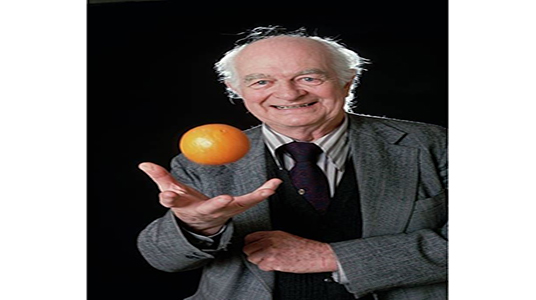He may be best remembered by ordinary people for advocating the use of high doses of Vitamin C for good health. But scientists respect and revere Linus Pauling as a remarkable chemist who achieved a string of amazing breakthroughs in diverse scientific fields. For many, after Albert Einstein, he is the second-most important scientist of the twentieth century. For still others, he is one of the greatest chemists of all time.
Widely acknowledged as the founder of molecular biology, quantum chemistry, and molecular genetics, Pauling was a prolific researcher whose work not only vastly increased our understanding of chemical bonding and chemical structure, but also endowed chemistry with a number of critically important concepts that have become commonplace today, like, for example, valence bond theory, electronegativity, resonance, and orbital hybridization. Pauling’s discovery of the alpha-helix structure of proteins cleared the path for the discovery of the double helix structure of DNA in 1953 by James Watson and Francis Crick. Pauling also made the ground-breaking discovery that sickle-cell anaemia is caused by malformed haemoglobin molecules and correctly postulated a new class of disease – molecular disease. No wonder Crick suggested that this consummate American scientist “should be regarded as the father of molecular biology”.
The only person to receive two unshared Nobel Prizes
Only two persons in Nobel Prize history have been awarded the prize in two different fields. The first was Madame Marie Sklodowska Curie who won the Nobel in Physics as well as Chemistry; the second was Linus Pauling awarded the Nobel in Chemistry and the Peace prize too. But as the sole recipient of both his Nobel prizes (Madame Curie shared her Physics Nobel with her husband Pierre and Henri Becquerel), Pauling achieved a feat that has not yet been matched by any other person.
Pauling’s first Nobel Prize was in Chemistry awarded to him in 1954 “for his research into the nature of the chemical bond and its application to the elucidation of the structure of complex substances”. Eight years later, in 1962, he won the Nobel Peace Prize in recognition of his dedication and commitment to humanitarianism, world peace, and nuclear disarmament.
On several occasions, Pauling had openly credited his wife Ava Helen Miller, also actively involved in peace movements, with bringing about the development of his social consciousness. He said she should have been picked for the Nobel Peace Prize instead of him or at least the two of them should have been given the prize jointly.
Assistant chemistry instructor at eighteen
Born on February 28, 1901 in Portland, Oregon, USA, Linus Carl Pauling was the first of three children born to Lucy Isabelle Darling and Herman Pauling, a pharmaceuticals salesman struggling to make ends meet. Unfortunately, when Linus was just nine years old, Herman died at the age of 33 of a perforated ulcer.
By the age of 15, Linus had enough school credits to go to college. He however still needed two mandatory civics credits to get his high school diploma. Though he promised to pass these exams while pursuing his college studies, his school – Washington High School, Portland – did not agree to this. But he left school anyway, and realising he would have to pay for his own college education, took up different odd jobs including delivering milk and working as a shipyard labourer. For a while he also worked as an apprentice machinist, and then at 16, enrolled at Oregon State Agricultural College in Corvallis (today’s Oregon State University) to study for a chemical engineering degree.
Recognising he was a brilliant student, the College helped him support his education and his sick mother by appointing him as an assistant chemistry instructor. He was just 18 then, and it was a hard task for him to work for 40 hours a week and yet make time for studies. Sadly, his mother died soon after that. It was at this college that Linus met his future wife, one of his students at that time. After graduating in chemical engineering, he completed his Ph. D. in physical chemistry and mathematical physics in 1925 from the California Institute of Technology (Caltech) with the highest honours. While studying at Caltech, he used the relatively new technique of X-ray diffraction to study the structure of crystals.
Thereafter, a Guggenheim Fellowship made it possible for him to study quantum mechanics in Europe for two years and acquire a better understanding of the behaviour of electrons in atoms. On returning to Caltech in 1927, he taught chemistry while at the same time carrying out research work in structural chemistry. He spent over three decades here as a teacher and researcher and then taught chemistry at Stanford University from 1969 to 1973.
Immediately after leaving Stanford, having developed an interest in health research, Pauling founded the Institute of Orthomolecular Medicine (renamed afterwards as The Linus Pauling Institute of Science and Medicine) to research nontoxic alternatives to medications. He was already 72 by then.
An interesting fact about Pauling’s life story is that despite being an outstanding student, he had been denied a high school diploma. And technically, he continued to be a failed high school student till, having realised how foolishly inflexible they had been, the school finally presented him with the diploma, 47 years late, in 1963. But it was nothing more than a superfluous gesture, for by then, he had already won two Nobel Prizes and gained recognition as one of the greatest scientists the world had ever seen.
The case for Vitamin C
At the institute he founded, the principal focus of Pauling’s research was the health benefits of large doses of vitamin C for a range of diseases from common cold and flu to cancer and heart disease. Before that, in 1970, he had published a bestselling book titled Vitamin C and the Common Cold based on his own investigations and experience.
Till then, no one had ever proposed a precise drug for curing or preventing common cold. Pauling himself had been consuming large doses of Vitamin C since 1965 and openly stated he had never suffered from the common cold since that time. People tended to believe him considering his reputation of being right about each of his many scientific breakthroughs. However, most scientists thought he was on a sticky wicket when it came to his claims about the efficacy of Vitamin C as a cure for various diseases.
Pauling nevertheless continued with his research and set up treatments that involved very large doses of vitamin C for cancer patients. But while he and his team claimed they got positive results from these tests, many other researchers said they could not replicate his results. Pauling refuted their findings saying they had not followed the same vitamin C dosing regimen that he had recommended and used.
Eclectic research interests, diverse discoveries, numerous achievements
For around a century after John Dalton put forth his atomic theory, scientists had been trying hard to find the answers to two critical questions: 1) What was the kind of bond that existed between atoms when they came together to form different substances? And 2) In what geometric pattern were atoms arranged when they formed molecules. Pauling was fascinated by these questions too. Ultimately, the extensive research he carried out in the fields of chemical bonding and chemical structure provided the answers to both.
During his scientific career spanning around seven decades, Pauling published over 1200 books and papers (authored solely or jointly) on wide-ranging scientific topics and also on humanism, war, and peace. His momentous book The Nature of the Chemical Bond is widely acknowledged as the most impactful scientific book of the twentieth century.
The list of prominent honours bestowed on Pauling would cover the length of this entire article. He received prestigious medals and awards for his scientific achievements as well as for his work as a peace activist.
Linus Pauling died at the age of 93 on 19 August, 1994, succumbing to prostate cancer. In the last years of his life, he had eased up on worldwide lecturing and foreign travel. But, a couple of years before he passed away, when he revealed he had prostate cancer, someone asked how come his daily dose of Vitamin C had not protected him from cancer. Not shying away from answering, Pauling calmly replied that had he not been taking the vitamin regularly, he would have had the cancer twenty years earlier.
Who’s to say for sure he wasn’t right?
References
1. Nobelprize.org: Linus Pauling – Biographical – Nobel Media AB 2014, https://www.nobelprize.org/prizes/chemistry/ 1954/pauling/biographical/
2. Profiles in Science: The Linus Pauling Papers – Two Nobel Prizes – US National Library of Medicine, https://profiles.nlm.nih.gov/ps/retrieve/Narrative/MM/p-nid/68
3. CosmosMagazine.com: Linus Pauling: The man who won two Nobel prizes – Cosmos Magazine, Issue 80, Spring 2018, https://cosmosmagazine.com/chemistry/linus-pauling-the-man-who-won-two-nobel-prizes
4. Stanford University: Linus Carl Pauling – https://chemistry.stanford.edu/people/pauling
5. Jack D. Dunitz: Linus Carl Pauling – Biographical Memoirs, V.71 (1997), Page 221
6. Barbara Marinacci: Linus Pauling Biography – Linus Pauling Institute, https://lpi.oregonstate.edu/about/linus-pauling-biography
7. ScienceHistory.org: Linus Carl Pauling – Science History Institute, 14 December, 2017, https://www.sciencehistory.org/historical-profile/linus-carl-pauling
8. Bart Barnes: Two-time Nobel Winner Linus Pauling dies at 93 – Washington Post, 21 August 1994
9. FamousScientists.org: Linus Pauling – Famous Scientists, https://www.famousscientists.org/linus-pauling.
9
































